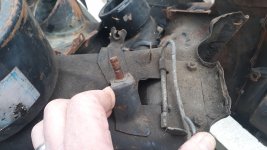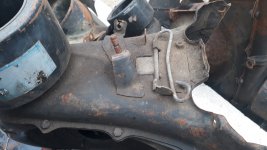You are using an out of date browser. It may not display this or other websites correctly.
You should upgrade or use an alternative browser.
You should upgrade or use an alternative browser.
Technical Flap on tinware next to Carb linkage.
- Thread starter MOD500
- Start date
Currently reading:
Technical Flap on tinware next to Carb linkage.
I have a set of tinware with an air flap on top next to the carb linkage. I've not seen one of these before, does anyone know what they were fitted to?
Yes I think that someone showed the same thing on this forum a couple of years back. Came from a later 650 engine I believe. There was some debate about its use. Favourite seemed to be that it could send a little cooling air past the carb. Another guy showed me exactly the same thing about two weeks ago and asked about it. The Polish 126 guys might know more.
the hobbler
Distinguished member
- Joined
- Jul 25, 2012
- Messages
- 4,070
- Points
- 1,011
That would sound sensible in very cold climates---a simple, almost bullit-proof device.
the hobbler
Distinguished member
- Joined
- Jul 25, 2012
- Messages
- 4,070
- Points
- 1,011
Thinking about it, it could be for either---the cooling air at the fan is going to have a certain amount of heat in it, so it MIGHT be to warm the carb. On the other hand, it could be for blowing cooler air than is being blown ACROSS the engine in order to COOL the carb. BUT, the question has to be---why would a country that has cold winters (Poland) fit a device to cool the carb?
It's for carb heating. The process of evaporating liquid, including petrol, causes cooling. This is how fridges work. Carbs evaporate petrol. In cold moist weather the cooling caused by the petrol evaporating causes ice to build up in the throat of the carb. The ice restricts the airflow and eventually stops the engine. It is particualry bad at steady low throttle settings.
Later cars had them operated automatically by a thermostat. Fuel injection dooes not suffer from icing so many car drivers do not know about it. I've experenced it and bsically while crusing you find your foot flat to the floor but not going any faster. It is a big problem in light aircraft, many of which still use carbs. It kills sseveral people a year. Aircrfy tend to have manual carb heat controls in the cockpit.
Robert G8RPI.
Later cars had them operated automatically by a thermostat. Fuel injection dooes not suffer from icing so many car drivers do not know about it. I've experenced it and bsically while crusing you find your foot flat to the floor but not going any faster. It is a big problem in light aircraft, many of which still use carbs. It kills sseveral people a year. Aircrfy tend to have manual carb heat controls in the cockpit.
Robert G8RPI.
the hobbler
Distinguished member
- Joined
- Jul 25, 2012
- Messages
- 4,070
- Points
- 1,011
The general consensus of opinion was the flap was help WARM the carburretor. This, in very cold climates can help stop 'icing'--a situation where the water in the air flowing into the carb literally forms a layer of ice inside the venturi of the carb. Senior members of the Forum will probably this problem, especially on the Ford Anglia. The trick was, when the engine died, leave it for a few moments so that the heat of the engine could filter through to the carb, let it melt the ice and then try starting the a car again---it normally started, and carried on as if nothing had happened.
The answer to your question is that you OPEN the flap in the cold weather and CLOSE it in the warm weather. To be honest though, in the UK the weather, at the time of the year when we drive the Fiats, rarely gets cold enough to warrent use of the flap.
The answer to your question is that you OPEN the flap in the cold weather and CLOSE it in the warm weather. To be honest though, in the UK the weather, at the time of the year when we drive the Fiats, rarely gets cold enough to warrent use of the flap.
- Joined
- Nov 26, 2020
- Messages
- 418
- Points
- 191
Its to stop icing in cold weather, if it's cold and your car starts to
loose power and in some cases cut out in cold weather often worse
in damp conditions set it to warm.
loose power and in some cases cut out in cold weather often worse
in damp conditions set it to warm.
Veloman518
Member
The only possible rebuttal, not based on any experience or data I have, is that the flap is before the cylinders and wouldn’t be that much warmer than the outside air it’s drawing in?
the hobbler
Distinguished member
- Joined
- Jul 25, 2012
- Messages
- 4,070
- Points
- 1,011
The answer to that query is that if that flap is open, it will allow some of the air around the engine to 'bounce back' up through the flap, and that air will have some warmth in it
The only possible rebuttal, not based on any experience or data I have, is that the flap is before the cylinders and wouldn’t be that much warmer than the outside air it’s drawing in?
I think you're correct. The Fiat 500 engine draws air through the cleaner via a long, narrow trumpet underneath that top casing of the cowling. Looking at those images I'd hazard that the flap turns in just in front of the entry to that device. A better way to avoid carb icing (incidentally...it's never been a problem even on the coldest days here in Scotland), would be to take in warmer air. The engine compartment, (especially when the bonnet louvres are blocked off as can be done with aftermarket, rubber flaps), is very warm, and I suspect that device is intended to allow a certain amount of warm air to be drawn into the inlet of the carb via the air-cleaner.
Last edited:



